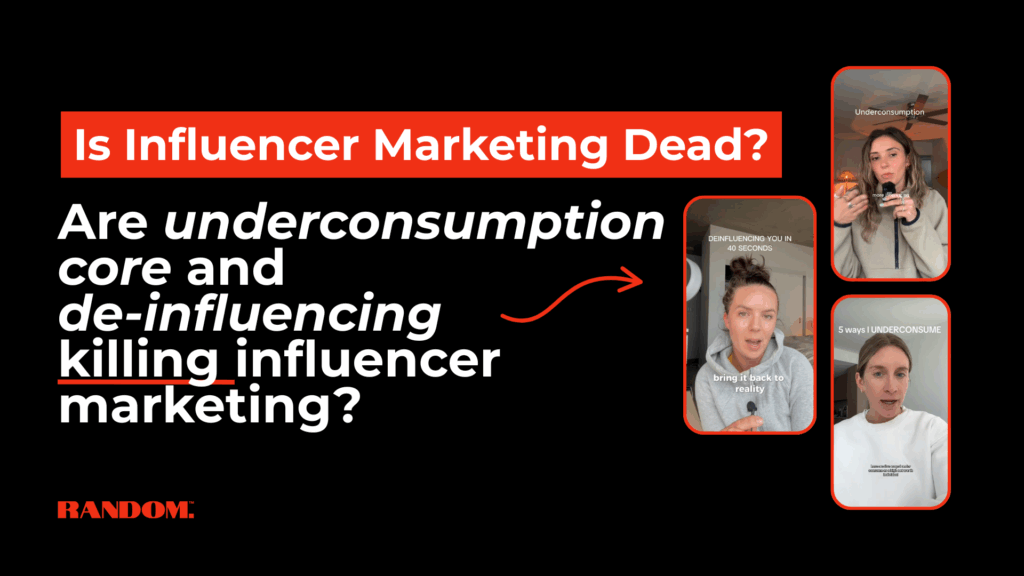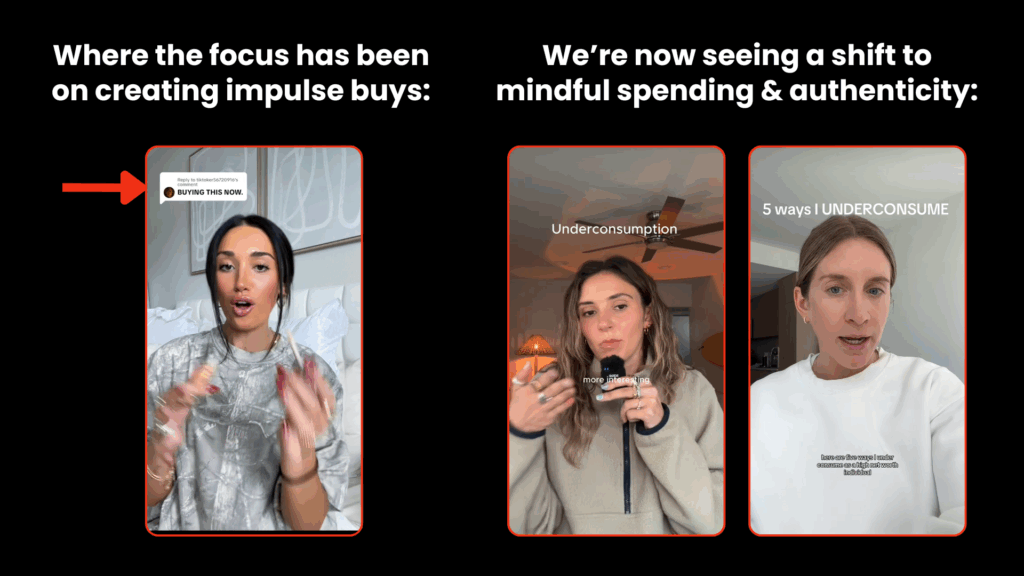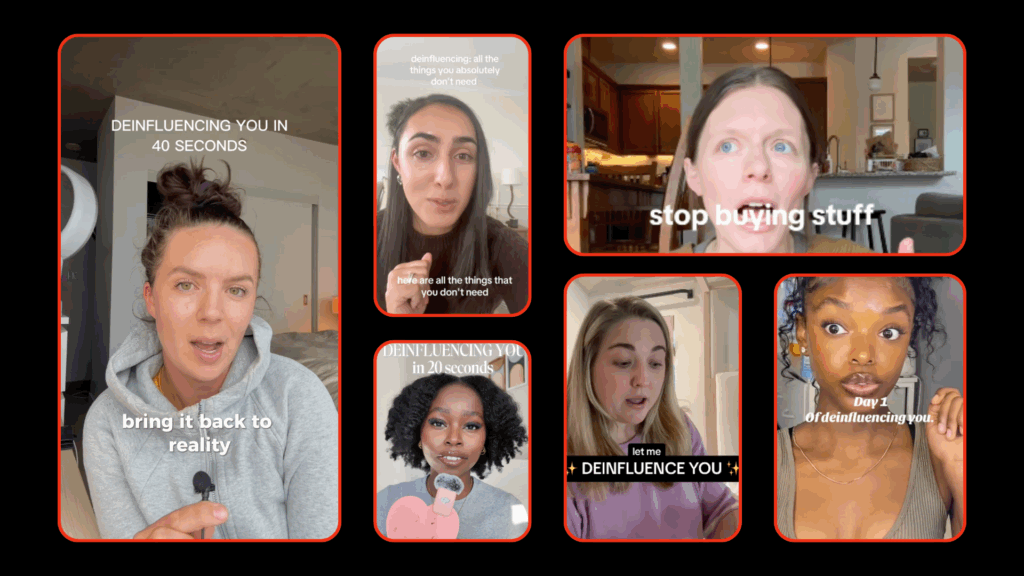
Influencer marketing has dominated the digital landscape for years. Brands have poured millions into influencer partnerships, capitalizing on the ability to reach millions of engaged followers and drive sales. But, as we move into 2025, there’s a growing shift in how consumers engage with influencers and their recommendations. The rise of underconsumption core and de-influencing challenges the traditional influencer marketing model.
In simple terms, underconsumption refers to the growing trend of scaling back on purchases in response to concerns about sustainability, minimalism, and financial strain. Meanwhile, de-influencing sees influencers encouraging their followers to resist impulse buys and think twice before purchasing. As these trends gain momentum, many question: Is this the end of influencer marketing? Are we witnessing the slow death of a marketing powerhouse, or is this simply the next evolution in how we connect with consumers?
Let’s break it down.
A shift is happening in consumer behavior, and it’s more than just a passing trend. With issues like climate change, financial instability, and the rising cost of living, more consumers, especially Gen Z, question the value of their purchases. The growing trend of underconsumption has created an environment where people actively choose to scale back, purchase less, and evaluate the actual value of the items they buy.

This mindset is shaking up traditional influencer marketing strategies, which typically focus on creating impulse buys. Instead of pushing consumers to purchase immediately, the conversation shifts to mindful spending and authenticity.
Why This Matters:
Consumers are questioning not only the products they buy but also whether they should buy at all. This change is forcing brands to rethink how they market products and how they align with values like sustainability and minimalism. The rise of underconsumption means brands can’t just rely on the classic “buy now” call-to-action; they need to adapt to their audience's changing mentality.
Now, here comes the twist: de-influencing. Influencers who once pushed products left and right now tell their followers to resist the urge to buy. These influencers are sharing their honest opinions, calling out over-hyped products, and encouraging their audiences to make more thoughtful purchasing decisions.

De-influencing is a considerable shift. Rather than pushing products, influencers champion self-awareness and encourage their followers to be more mindful of their consumption habits. Brands that are so used to influencers promoting everything under the sun now have to ask: "How do we remain relevant in an age where being ‘too promotional’ is starting to feel disingenuous?"
Take this video from TikTok creator @chelseapursuit for example. Here we see Chelsea challenging influencer culture that prioritizes constant consumerism. She speaks for those calling for a digital environment where, instead of pushing every new skincare product, creators emphasize mental health and mindful spending. Chelsea is just one creator who reflects the growing desire for authenticity and intentionality in product recommendations.
So, does this spell the end for influencer marketing? Not exactly. The industry is evolving. Influencer marketing isn’t going anywhere but shifting toward a more ethical, thoughtful, and transparent model. While underconsumption and de-influencing are challenging traditional methods, they also allow brands to evolve their approach to influencer partnerships.
Brands that continue to work with influencers like they did five years ago may struggle in 2025. But brands that embrace authenticity and responsibility in their influencer relationships are positioned to thrive.
If you’re a brand wondering how to thrive in this new influencer landscape, here’s the lowdown
Gone are the days of influencers pushing every product under the sun. Consumers—especially younger generations—want to see honest, unfiltered feedback. So, partner with influencers who align with your values and offer genuine reviews, not just sales pitches.
Consumers are more eco-conscious than ever and expect the brands they support to reflect those values. Instead of encouraging followers to buy “more stuff,” work with influencers who promote sustainability and thoughtful consumption.
Example: Brands like Patagonia have long championed sustainability, and influencers who align with those values are more likely to create authentic, engaging content that resonates with today’s socially conscious consumer.
Instead of pushing for instant purchases, encourage influencers to focus on educating their audiences. Help them make informed decisions. Use content that helps followers evaluate whether the product is right for them, not just if it’s trending.
This could mean educational videos, product comparison posts, or reviews that highlight the pros and cons of a product. The goal is to foster a deeper, long-term relationship with the audience.
In a world where consumers want more than quick fixes, it's time to adopt mindful marketing strategies. Instead of constantly urging consumers to buy, encourage them to invest in experiences, self-improvement, or sustainable products. This approach builds brand loyalty and trust, which is far more valuable than a quick sale.
While underconsumption and de-influencing are challenging traditional practices, they also create new opportunities for brands to focus on authenticity, sustainability, and consumer trust. Influencer marketing isn’t dying—it’s evolving into something more meaningful and impactful.
Brands that embrace these shifts and align themselves with influencers who prioritize ethics and transparency will be the ones who succeed in this changing landscape.
At RANDOM, we’re here to help you navigate this shift and create impactful influencer strategies that speak to today’s socially-conscious consumers. Ready to embrace the future of influencer marketing? Let’s chat!